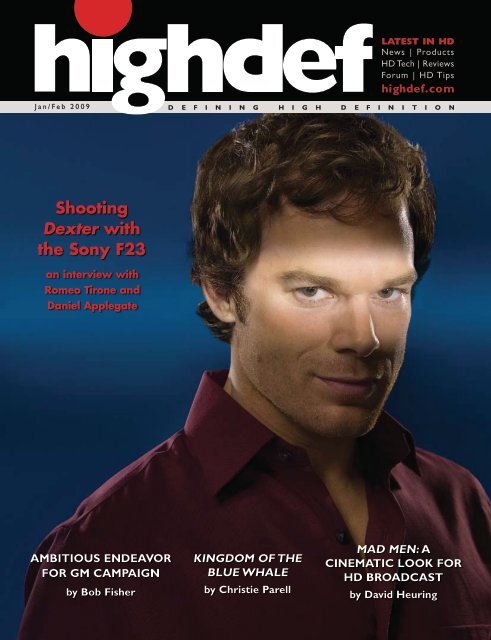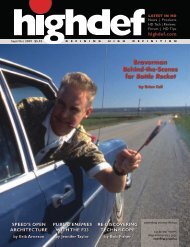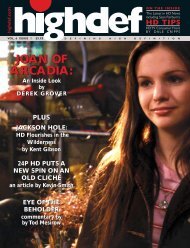Shooting Dexter with the Sony F23 - HighDef
Shooting Dexter with the Sony F23 - HighDef
Shooting Dexter with the Sony F23 - HighDef
- No tags were found...
Create successful ePaper yourself
Turn your PDF publications into a flip-book with our unique Google optimized e-Paper software.
<strong>Shooting</strong><strong>Dexter</strong> <strong>with</strong><strong>the</strong> <strong>Sony</strong> <strong>F23</strong>an interview <strong>with</strong>Romeo Tirone andDaniel ApplegateAmbitious EndeavorFor Gm Campaignby Bob FisherKingdom of <strong>the</strong>blue whaleby Christie ParellMad Men: ACinematic Look forHD Broadcastby David Heuring
© Kodak, 2009. Kodak and Vision are trademarks.c o n t e n t shighdef.com6F e a t u r e<strong>Shooting</strong> <strong>Dexter</strong> <strong>with</strong> <strong>the</strong> <strong>Sony</strong> <strong>F23</strong>an interview <strong>with</strong> Romeo Tirone and Daniel Applegate612Ambitious Endeavour for GM Campaignby Bob Fisher14Kingdom of <strong>the</strong> Blue Whaleby Christie Parell1215Ski Patrol in High Definitionby William Wheeler16HDTV Forum: No OLED TV’s from Samsungby Steve Sechrist17RED One Under Waterby Michael Piotrowski1918HD Tips: Exposureby B. Sean Fairburn19Mad Men: A Cinematic Look for HD Broadcastby David Heuring20Decoding Christianityby David Royle2021High Definition Makeup: A Star is Bornby Bradley M. Look22Scientific Discovery in HDby Andrew Scafetta22Front Cover: Michael C. Hall as <strong>Dexter</strong> Morgan. Photo courtesy of Showtime.Vol. 11, Issue 1 | <strong>HighDef</strong> Magazine is published bi-monthly, free for professionals in all areas of video and film production, nationally by American Press Services, 2247 15 th Avenue West, Seattle, WA98119. PUBLISHER: Conrad W. Denke EDITOR: David W. Thompson PRODUCTION: Gina Griffin Hanzsek DISPLAY ADVERTISING: Call David Thompson at 1-888-282-1776 or e-mail david@highdef.com. Deadline for advertising mechanicals is fifteen(15) days prior to publication date. Current and back issues and additional resources, including subscription request forms, are availableon our website: www.highdef.com. Address changes can also be done online at www.highdef.com/subscribe or mail changes to: <strong>HighDef</strong> Magazine, 2247 15 th Ave. West, Seattle, WA 98119.
<strong>Shooting</strong> <strong>Dexter</strong><strong>with</strong> <strong>the</strong> SONY <strong>F23</strong>Photo by Peter Iovino/ShowtimeAn interview <strong>with</strong> Romeo Tirone – Director of Photography and Daniel Applegate – Digital Imaging TechnicianQ. Romeo, tell us about <strong>the</strong> production of <strong>Dexter</strong> and <strong>the</strong> use of <strong>the</strong> <strong>Sony</strong> <strong>F23</strong>?RT: This is my first TV series and first HD project of this scope. It was definitely my decision toswitch to <strong>F23</strong>. Last season <strong>Dexter</strong> was a hybrid show, shooting on HD and film. Sometimes itbecame complicated going back and forth between one and <strong>the</strong> o<strong>the</strong>r so I was looking for anew camera. The way <strong>F23</strong> looks and <strong>the</strong> latitude on it is so broad I feel like now I have to lightit more like film, where last year <strong>with</strong> <strong>the</strong> first generation 24P camcorder I had to bring my highlightsdown, where I would use a 20k I used 10k. It allows for more contrast, <strong>the</strong> es<strong>the</strong>tics aremore pleasing. It really captures all <strong>the</strong> information especially in highlights.Q. Daniel you’ve been <strong>with</strong> <strong>the</strong> show from <strong>the</strong> beginning. Were you happy <strong>with</strong> <strong>the</strong> switch?DA: It’s frustrating when you are shooting and look at <strong>the</strong> window and it’s just a white hole, so Itold <strong>the</strong>m about <strong>F23</strong>. The producers actually looked into RED but everyone felt it wasn’t readyfor <strong>the</strong> television show, so we kept pushing <strong>F23</strong>. We finally got it through Panavision and wepretty much were able to keep everything <strong>the</strong> same - just switched <strong>the</strong> camera.Q. How was <strong>the</strong> post-production process affected?RT: If <strong>the</strong> <strong>F23</strong> made it harder for post it would have been a problem. What we do is shoot <strong>with</strong>HDCAM SR tape and dub down to HDCAM, so <strong>the</strong>ir post workflow stays exactly <strong>the</strong> same.(L – R) James Remar as HarryMorgan, C.S. Lee as VinceMasuka, Michael C. Hallas <strong>Dexter</strong> Morgan, LaurenVelez as Lt. Maria Laguerta,David Zayas as Angel Batista,Julie Benz as Rita Bennett,and Jennifer Carpenter asDebora Morgan6 7
Michael C. Hall as <strong>Dexter</strong>Morgan and Jimmy Smitsas Miguel Prado8However, post loves what we are getting,because <strong>the</strong>re is so much more range, so muchmore detail so <strong>the</strong>y have more wiggle room.DA: Of <strong>the</strong> newer cameras, <strong>the</strong> <strong>F23</strong> is <strong>the</strong>only one where we can actually burn <strong>the</strong> lookin <strong>with</strong>out making LUTs, o<strong>the</strong>rwise we wouldmake <strong>the</strong> LUTs, send <strong>the</strong>m in, and <strong>the</strong>n hopethat in dailies, <strong>the</strong> right LUTs are applied to<strong>the</strong> right scenes. We don’t protect <strong>the</strong> highlightsor <strong>the</strong> shadows. If we want somethingblown out we blow it out. We’ve been toldthat <strong>the</strong>y want <strong>the</strong> dailies to look like <strong>the</strong>show is going to look, so that’s what we do.I do try to have a little bit more information<strong>the</strong>re so if <strong>the</strong>y do want to bring it down <strong>the</strong>yhave <strong>the</strong> option, but overall if it’s going to besunny, we want a hot background.RT: There is a distinctive look to <strong>Dexter</strong>. Idescribe it as a graphic novel <strong>with</strong> Scorsese/Cronenberg/Kubrick influence. And we reallytry to keep it that: low wide angle lenses, lotsof movement in <strong>the</strong> camera, <strong>the</strong> drama of <strong>the</strong>lighting. We really try to create different looks;I change <strong>the</strong> color completely for kill scenes,flashbacks and now for flash-forwards for thisseason. In flash-forwards we are using a neton <strong>the</strong> rear of <strong>the</strong> lenses to create a dreameffect look, but <strong>the</strong>n sharpening it up <strong>with</strong> <strong>the</strong>shutter.Photo by Peter Iovino/ShowtimePhoto by Peter Iovino/ShowtimeWe are shooting hyper gammas and arefinding <strong>the</strong>y are working really well for us. Ittook us sometime to learn <strong>the</strong>m. There arefour different ones for different purposes, andI think now we have a really good handle onit. We can look at a situation and know whichhyper gamma to go to and get <strong>the</strong> informationwe need. The <strong>F23</strong> gives me <strong>the</strong> freedomto create <strong>the</strong> look on set ra<strong>the</strong>r than havesomeone else do it in <strong>the</strong> final color correct.It’s <strong>the</strong> only place where I can really stamp it inand not have to worry about someone doingsomething completely different in post.I try to use color as an emotional underlineof what is going on in <strong>the</strong> show. If Idecide to make a certain scene warm or coolor green, post understands that and uses <strong>the</strong>‘painted in’ look as a basis for color correcting<strong>the</strong> scene. With night scenes we’ve been turningdown <strong>the</strong> gain of <strong>the</strong> camera to -3 ra<strong>the</strong>rthan pushing as we had usually in <strong>the</strong> past.This of course meant that I have to add morelight, and <strong>the</strong> result is much richer and moredetailed shadows, plus reduced noise comparedto <strong>the</strong> normal +3.Most of <strong>the</strong> time I shoot wide openbecause of depth of field. I light by eye not bymeter so it tends to be wide open whe<strong>the</strong>r Ilike it or not. I think it’s getting closer and closerto film. I am curious what<strong>the</strong> F35 will bring us <strong>with</strong> beingable to use 35 mm lenses andusing film lens language.Q. Do you do any in cameraeffects?RT: A lot of <strong>Dexter</strong>’s point-ofviewsare done <strong>with</strong> speedchanges, so we’ll go fromnormal speed to 48 fps orsometimes from 12 fps to 48fps, and we’ve been doingthis <strong>with</strong> <strong>F23</strong> flawlessly. Whenwe were doing this before<strong>with</strong> a film camera, you’d endup doing two or three extratakes, just to make sure yougot <strong>the</strong> right effect. Where<strong>with</strong> this you shoot it, youplay it back and you know younailed <strong>the</strong> right moment. I’musually <strong>the</strong> one who does <strong>the</strong>speed changes, so I’m rightbehind <strong>the</strong> camera turning<strong>the</strong> knob, which is actuallyvery helpful, because I’m right<strong>the</strong>re <strong>with</strong> <strong>the</strong> actors and cansee <strong>the</strong> line and really hit it.Q. In which areas would youlike to see improvement?RT: With <strong>F23</strong>, we still havesome physical limitations, <strong>the</strong>hand-held devices are still alittle awkward, it balances correctly<strong>with</strong> <strong>the</strong> tape deck on it,but when you remove <strong>the</strong> deckall <strong>the</strong> weight goes forward.On some of <strong>the</strong> sceneswe’ve incorporated <strong>the</strong> smallerEX1 <strong>with</strong> <strong>the</strong> <strong>F23</strong>, like in an elevatoror car interior. It’s actuallypretty amazing how well <strong>the</strong>camera cuts <strong>with</strong> <strong>the</strong> <strong>F23</strong>.I think HD is getting betterand better. I embrace HD,I like it, and I never shy awayfrom it. When I got this showit was mandatory to shoot onHD, but because of all <strong>the</strong>speed changes that we do,<strong>the</strong>re were times when I’dshoot <strong>the</strong> film camera andHD camera side by side. Weno longer have to do this.And that’s cost effective forproducers. Also, I find youreally feel <strong>the</strong> benefits in yournight exteriors or <strong>the</strong> low lightwork. On <strong>the</strong> o<strong>the</strong>r hand <strong>the</strong>reis a little bit more romancein film it makes things look alittle nicer. Like for example,because of HD’s amazingdetail, it’s unforgiving to people’sfaces and we embracethat. However we do try toplay <strong>with</strong> filters to try to helpskin tones, but <strong>the</strong> show is nota glamour show. It has thathard edge to it. Although wedo try to make people on <strong>the</strong>show look good, that’s not <strong>the</strong>first priority. Visual storytellingto compliment <strong>the</strong> script isour main goal. HDRomeo Tirone seized <strong>the</strong>opportunity to go freelance asan Assistant Cameraman on<strong>the</strong> groundbreaking hit musicvideo for Run DMC Aerosmith’sWalk This Way. His commercialreputation for “TabletopCinematography” as well as“Live Action Cinematography”steadily grew, working<strong>with</strong> nationally recognizedcompanies such as Giraldi,Red Tree and Radical Media.<strong>Shooting</strong> Feature Films remainsRomeo’s passion. His work hasbeen in <strong>the</strong> Sundance FilmFestival (L.I.E. 2001) and TheToronto Film Festival (Twelveand Holding 2005). Romeohas always embraced newtechnologies.Daniel Applegate’s recent DigitalImaging Technician experiencesinclude: Flirting <strong>with</strong> Forty(2008), Sons of Anarchy (2008),Austin Golden Hour (2008) andThe Riches (2007-2008).Michael C. Hall as<strong>Dexter</strong> Morgan andJames Remar asHarry Morgan9
We never leave wellenough alone.As we always do, we’ve taken our hottest product and made it better. Westarted <strong>with</strong> <strong>the</strong> 1920 x 1080 recording and SxS PRO memory cards of <strong>the</strong>PMW-EX1 camcorder. Then we added <strong>the</strong> versatility of interchangeablelenses, <strong>the</strong> fl exibility of Gen Lock and Time Code jacks and <strong>the</strong> power of8-pin interface for full studio remote control. Presenting <strong>the</strong> EX1’s biggerbro<strong>the</strong>r, <strong>the</strong> PMW-EX3. To see all <strong>the</strong> o<strong>the</strong>r ways <strong>Sony</strong> is exceedingexpectations, visit us online.click: sony.com/prohdna© 2008 <strong>Sony</strong> Electronics Inc. All rights reserved. Reproduction in whole or in part <strong>with</strong>out written permission is prohibited.Features and specifi cations are subject to change <strong>with</strong>out notice. <strong>Sony</strong>, HDNA, <strong>the</strong> HDNA logo and SxS PRO are trademarks of <strong>Sony</strong>.
AmbitiousEndeavor for GM Campaignby Bob Fisher(L – R) Director Tim Damonand cinematographerBill Bennett, ASC <strong>with</strong>gaffer Dennis Wehr (back)contemplate a shot for <strong>the</strong>irGM running footage project.William (Bill) Bennett, ASC recentlycompleted shooting his “mostambitious endeavor” for directorTim Damon of Damon Live Action. Bennetthas earned more than 1,000 cinematographycredits for shooting television commercials incollaboration <strong>with</strong> a who’s who list of directorsat locations around <strong>the</strong> world.Bennett and co-cinematographer GregBaldi shot 100,000 feet of running footageof General Motors cars and trucks that isbeing used to create national, regional andlocal commercial campaigns introducing 54Chevrolet (Buick), Saturn (Pontiac) and BPG(GMC) vehicles in both HD and standard televisionformats, and also for video displays atdealerships and DVDs.The package was produced by DamonLive Action, and marked Bennett’s eighthproject for Damon during <strong>the</strong> past year anda half. Caroline von Weyher was executiveproducer, <strong>with</strong> Nancy Fulton fulfilling line producingduties, and Scott Luhrsen as 1st AD.The Damon Live Action team spent monthsplanning <strong>the</strong> effort, and collaborated closely<strong>with</strong> creative directors from ad agencies,including Campbell-Ewald, Deutsch, Inc. andLeo Burnett.“Television commercials are about lifestyles,”Bennett observes. “You have just 30seconds to connect <strong>with</strong> individual viewerson an emotional level. We want <strong>the</strong>m to feelwhat it’s like to drive <strong>the</strong>se vehicles in beautifulenvironments.”The running footage was produced atlocations in and around Salt Lake City, Utah,and Denver, Colorado. These locations werechosen by Damon because <strong>the</strong>y providedan array of attractive backgrounds, includinghigh-density residential and retail neighborhoodsin urban settings, and country roadssurrounded by trees, farms and lush greenPhoto by Ambar Capoorgrass. The agencies also wanted deep blue,sunlit skies. Production was scheduled duringmid-mornings and late afternoons when<strong>the</strong> sun was low in <strong>the</strong> sky, yet still above <strong>the</strong>horizon.“It was obvious that we needed <strong>the</strong> latitudeand nuanced palette of colors, contrastand textures that film provides,” Bennett says.“We captured <strong>the</strong> footage mainly on a 250-speed (KODAK VISION2 5205) four-perf film,which enabled us to use longer and slowerlenses when <strong>the</strong>y were needed. We also shotsome scenes at higher frame rates for slowmotioneffects. The images were composed in4:3 aspect ratio while protecting for 16:9.”Choreographing <strong>the</strong> shoot was like producinga complex ballet. There were some120 people involved, including teamsters whoused 14 tractor-trailers to haul and deliver <strong>the</strong>picture vehicles to <strong>the</strong> right places at <strong>the</strong> righttimes. Four camera crews were working simultaneously.Damon created “shopping lists” of<strong>the</strong> desired interior and exterior shots, includinginstructions for close-up, medium andlong shots, camera angles and movement.The shopping lists consisted of still images ofexterior and interior shots, including anglesthat art directors at <strong>the</strong> agencies requested.Features of people inside <strong>the</strong> cars aren’tvisible because <strong>the</strong> agencies want audiencesto imagine <strong>the</strong>mselves behind <strong>the</strong> wheel.Windows were coated <strong>with</strong> a 50 percent“transmission” gel that turned drivers intosilhouettes, <strong>with</strong> <strong>the</strong> exception of close-upsof hands pushing buttons, opening compartments,etc.Bennett recorded images <strong>with</strong> anARRIFLEX 435 Xtreme camera mounted <strong>with</strong>an Angenieux 17-102 mm zoom lens. Thecamera was on a Technocrane <strong>with</strong> a FlightHead. Baldi’s unit filmed moving cars <strong>with</strong>an ARRI 435 ES camera mounted <strong>with</strong> anAngenieux 15-40 mm Optimo zoom lens. Thecamera was on a Filmotechnics Pro ActionArm and Flight Head mounted on DamonLive Action’s Porsche Cayenne. The third unit,headed by Thom Cox, concentrated on filmingcar interiors <strong>with</strong> an ARRIFLEX 235 camera<strong>with</strong> Zeiss Ultra Prime and Revolution snorkellenses on a miniaturized, motorized dolly thatBennett designed. The fourth unit was shootingcars on Damon’s turntable <strong>with</strong> a custom,carbon fiber arm used to place it in a fixedposition 10 or more feet from <strong>the</strong> car.Front-end lab work was done byFotoKem in Burbank, California. RIOT inSanta Monica handled telecine transfer andprovided dailies. HDA shot of <strong>the</strong> ChevyColorado for <strong>the</strong>GM running footagecampaign.12 13Photo by Tim Damon
Kingdom of <strong>the</strong>Blue Whaleby Christie ParellPhoto credit © Dave Adams / NGTAbove: Dr. Bruce Mate,Director of <strong>the</strong> MarineMammal Institute atOregon State University,and John Calambokidis,Research Biologist ofCascadia Research, prepareto tag a whale.Right: Supported by <strong>the</strong>National GeographicSociety, scientists embarkon a revolutionary missionto find, Identify and tagCalifornia blue whales usingDNA samples.Blue whales are <strong>the</strong> largest creatures toever live on our planet – larger thanany of <strong>the</strong> great dinosaurs. They are sorare that even experts know little about <strong>the</strong>m.National Geographic Channel’s new high-definitionspecial, Kingdom of <strong>the</strong> Blue Whale,takes us on a journey over thousands of milesthrough remote waters to unlock <strong>the</strong> secretsof blue whales and investigate why more aredying than ever before.Filmed during sea voyages off <strong>the</strong> coastsof California and Costa Rica, and culled fromhundreds of hours of original spectacular HDphotography, <strong>the</strong> two-hour special follows<strong>the</strong> crew as <strong>the</strong>y discover where <strong>the</strong> EasternNorth Pacific Blue Whales mate, calve, andfeed in <strong>the</strong> winter.Using National Geographic’s cuttingedgeCrittercam®, an integrated videocamcorderand data logging system thatattaches to <strong>the</strong> whale’s back <strong>with</strong> suction, thisspecial features <strong>the</strong> first-ever footage of <strong>the</strong>blue whale gulping krill – from <strong>the</strong> whale’sperspective. Five o<strong>the</strong>r HD cameras were alsoused, including <strong>the</strong> <strong>Sony</strong> F900, <strong>Sony</strong> PMW-EX1, Panasonic HDX900, Panasonic P2, andPanasonic Varicam.The rare Blues spend virtually all of <strong>the</strong>irlives underwater and surface for only secondsat a time. Regarding access to film <strong>the</strong>m,producer Sue Houghton says, “There are onlya limited number of ‘approaches’ for endangeredwhales on each scientific permit, and<strong>the</strong> scientists would ra<strong>the</strong>r use <strong>the</strong>m for <strong>the</strong>irown research… Filming whales is <strong>the</strong> hardestthing I’ve ever done, because <strong>the</strong>y’re so big,so fast, so few, and <strong>the</strong>re are so many limitationson what film crews can do, and whenand how <strong>the</strong>y do it.”In one season alone, four blue whaleswere killed by apparent ship strikes. Aswhale expert Steve Palumbi says, “It’s probablyharder to be a whale than it’s ever beenbefore…I think we have <strong>the</strong> power to protect<strong>the</strong>m and let <strong>the</strong>m have that chance.” HDKingdom of <strong>the</strong> Blue Whale premieres Sunday,March 8, 2009.Photo credit © Dave Adams / NGTSki Patrolby William WheelerProducing Ski Patrol: Crystal Mountain,a new HDTV “reality” series about <strong>the</strong>daring rescuers of skiers on treacherousalpine slopes, is a current assignment of LosAngeles-based Varuna Entertainment. Theseries (on truTV) features dramatic HD videoof avalanches, rescues, and skiiing in extremeenvironments. Capturing <strong>the</strong> cinema veritéstyle of <strong>the</strong> series in HD necessitated <strong>the</strong> useof a compact, lightweight camera.“Canon’s XH G1 HD camcorder workedgreat for this series,” notes DP Chun MingHuang. “Its 20x zoom lens is fast. And youcan start off pretty darn wide and go in prettydarn tight.”“Some of <strong>the</strong> skiing shots were capturedby our camera operators holding <strong>the</strong> camcorderson monopods,” explains producer PremaBall. “Occasionally <strong>the</strong> operators would fall,and it was much better that <strong>the</strong>y were holding<strong>the</strong> lightweight XH G1 than a heavier ENGcamera, which could cause as much damageto an operator as <strong>the</strong> fall itself.”“The XH G1 is light enough to be heldin High Definitonwhile skiing but also produces excellentimage and sound quality, even though we put<strong>the</strong>m through a pounding for 12 weeks on <strong>the</strong>mountain,” says Bryan Stratte, director of <strong>the</strong>series. “<strong>Shooting</strong> this type of show doesn’tgive you <strong>the</strong> luxury of set-up times or secondtakes. It’s all in <strong>the</strong> moment.”Features of <strong>the</strong> three-CCD XH G1includes multiple frame rates and industrystandardconnections for genlock, HD-SDI/SD-SDI output, and SMPTE time code I/O.“The XH G1’s time code connector is alife-saver for reality production,” Ball elaborates.“We shoot a tremendous amount offootage, and time code gives us <strong>the</strong> abilityto jam-sync multiple cameras. On Ski Patrol:Crystal Mountain we had four camera crewsspread out all around <strong>the</strong> mountain. In anemergency <strong>the</strong>y’d all get a call over <strong>the</strong> radioto get to a certain location. If all <strong>the</strong> XH G1’shadn’t been jam-synced at <strong>the</strong> beginning of<strong>the</strong> day, <strong>the</strong>y’d all be on different time codesand it would have been a post nightmare.”HDSki Patrol being shot in HDby DP Chun Ming Huang.14 15Photo by Brooks Werner
hdtvForumb y s t e v e s e c h r i s tSteve Sechrist isan editor/analystat Insight Media, atechnology basedmedia firm specializingin large format andmicro display andrelated industries.Prototype Canon SEDDisplay couldn’t beat<strong>the</strong> odds.No OLED TV’s from SamsungSamsung vice president, H.S. Kim in <strong>the</strong> FlatPanel Development division, announced that<strong>the</strong>y will not bring OLED TVs to market anytimesoon. The reason, <strong>the</strong> technology is currentlyconsidered too expensive, and customerswould not pay <strong>the</strong> premium, as OLED setswould cost 10 times as much as equivalentLCD or plasma HDTVs, Kim says.In a compelling story in Mobile DisplayReport, display analyst Ken Werner wrote:“The odds against successfully bringinga new display technology to market areimmense, if not quite infinite. The problem isthat <strong>the</strong> entrenched technology – CRTs nottoo long ago, LCDs and PDPs now – developssuch a massive manufacturing infrastructure,such an efficient supply chain, and sucha wealth of processing know-how for enhancingyields and reducing costs that it’s virtuallyimpossible for a new technology to directlycompete.”In <strong>the</strong> large display AMOLED space, wemay be facing similar odds, and <strong>the</strong> Samsungannouncement could be <strong>the</strong> canary in <strong>the</strong>coalmine. While small OLEDs have establishedgood traction in portable products likecell phones and personal devices, migrating<strong>the</strong> emissive OLED technology up stream hasproven much more challenging. Adding to<strong>the</strong> problem, <strong>the</strong> life/color and yield requirementsfor large display TVs is much morerigorous than that of small cell phone screensand <strong>the</strong> like, as evidenced in <strong>the</strong> recentSamsung announcement.So what will Samsung do in <strong>the</strong> meantime?In an Electronista article it was stated,“Instead <strong>the</strong> electronics giant will continueto focus on developing its current LCD andplasma TVs, improving <strong>the</strong>ir performancewhile making <strong>the</strong>m thinner and more efficient.This will involve working on integrating 200Hzpanels and LED backlighting into its sets, <strong>with</strong>more advanced local dimming LED backlightingand LED edge-lighting to be used in higher-endsets in order to make <strong>the</strong>m super-thin.OLED panels can be just 3mm thick, though<strong>the</strong> TV itself would need to be 25mm thick(just over an inch), which is what LCD HDTVsare approaching.”Samsung <strong>with</strong> multi-generational LCDfabs and billions of dollars already invested,has that luxury to choose between <strong>the</strong> twotechnologies; and given <strong>the</strong> current economicclimate, <strong>the</strong> safe bet is on making LCD morecompetitive, and more profitable.But o<strong>the</strong>rs like <strong>Sony</strong> don’t have thatluxury and are committed to making (largesized) OLED-TVs a reality in 2009. For <strong>Sony</strong>’ssake let’s hope those process engineersknow something about making large OLEDdisplays that <strong>the</strong> Samsung boys haven’t figuredout. Suffice it to say, it’s going to be aninteresting year in <strong>the</strong> display industry. HDRED OneUnder Waterby Michael A. PiotrowskiRecently, Jordan Klein Jr., veteran underwatercinematographer, collaborated<strong>with</strong> Tampa Digital Studios, a large digitalmedia production company in Florida, tosubmerge underwater, for <strong>the</strong> first time, RedDigital Cinema’s RED One to capture swimscenes for a television commercial.The 10-pound camera was placed insidea housing made of 6061 aircraft aluminum.Klein built <strong>the</strong> red-colored casing, knownas Liquid Red, that weighs 80 pounds. Theencased camera was hoisted into a pool setusing a crane device to remotely control <strong>the</strong>camera’s movement from dry land.“I noticed a need in <strong>the</strong> industry, and Iwanted to develop it first,” said Klein, whooperated RED One. “From a technologystandpoint, I feel that <strong>the</strong> professional housingfor <strong>the</strong> RED One is as important to <strong>the</strong>industry as <strong>the</strong> Steadicam or Technocrane.”In December 2008, <strong>the</strong> RED One waslowered into a home pool for <strong>the</strong> filming ofa 30-second spot for Pinch A Penny, a largeretail pool supply company in <strong>the</strong> Sou<strong>the</strong>ast.The camera’s underwater housing used threeelectric motors to control <strong>the</strong> lenses—focus,Iris and Zoom. Klein shot <strong>the</strong> action usingan electronic viewfinder, also housed in anunderwater casing, and electronic cameracontrols.Because <strong>the</strong> camera and lens functionsare electronically controlled, <strong>the</strong> housing iscapable of being fully remote controlled.Klein said this makes Liquid Red ideal toshoot in hazardous environments or <strong>with</strong>crane operations.“The folks at Red Digital helped us <strong>with</strong><strong>the</strong> wiring schematics for <strong>the</strong> camera controlfunctions,” Klein added. HDMichael A. Piotrowski is a producer and publicrelations director at Tampa Digital Studios. www.tampadigital.com, 813.241.2012Above: An underwaterscene from <strong>the</strong> completed30-second Pinch A PennyPools spot.Top: DP Jordan Klein, Jr.(left, operating camera)and commercial directorRob Tiisler (right, on pooldecking) planning a shot.16 17Photos courtesy of Tampa Digital Studios
hdTipsb y B . S e a n F a i r b u r n S O CB. Sean Fairburn, SOCDirector of Photography,Role Model Productions,LLC. rolemodel@earthlink.netSeanfairburn.com818-621-3912Local 600,Agent Steve Jacob,323-460-4767Day exterior scenes likefestival rides properlytuned maintain color andcontrast.ExposureExposure is a recipe made upof a variety of ingredients.Blacks, gammas or midsand highlights are <strong>the</strong> basicelements. Most people don’tever take a moment to adjust<strong>the</strong> ratios any more than <strong>the</strong>way <strong>the</strong> camera was set upwhen it was purchased.To properly take advantageof <strong>the</strong> wealth of choices concerningexposure, <strong>the</strong> questionto ask yourself is “What do Iwant to properly expose?”The main subject of<strong>the</strong> shot generally gets <strong>the</strong>primary consideration, buthighlights are what can’t befixed in post. Therefore sethighlights <strong>with</strong> <strong>the</strong> iris keepingwhites around 100-103.Turning on DCC (DynamicContrast Control) will help getmore information out of yourhighlights.Actors flesh tones generallyfall in <strong>the</strong> mids and shouldbe considered next. Underexposing is safe, but using <strong>the</strong>gamma dial on <strong>the</strong> camera tolift or drop <strong>the</strong> gamma leveltakes only a few seconds toget what you want it to looklike exactly. Black pedestalshould not be touched after itgets set at 0.However a similar effectcan be done <strong>with</strong> tweaks to<strong>the</strong> black gamma that will giveyou a rich contrasty look (lowering<strong>the</strong> level) or by raisingto show you more informationin <strong>the</strong> dark grey areas of <strong>the</strong>frame. You must get familiar<strong>with</strong> how?, when? and in whatdirection? to make <strong>the</strong>setweaks. Your image will greatlybenefit from <strong>the</strong> extra care.For instance bright dayexterior: Expose for highlights(sky <strong>with</strong> a ND.6 Grad) at 103IRE, take gamma down to -20and black gamma set at 35%to -40. This will make <strong>the</strong> scenea bit more colorful and add abit more contrast.Night exterior streetscene: Expose for brightestlights, take gamma up to +30and black gamma set at 50%to +50. This will pull out moreinformation in <strong>the</strong> dark areasand provide an overall brighterscene <strong>with</strong>out gain and excessivenoise.You have my permission toexperiment. HDMad MenA Cinematic Look for HD Broadcastby David HeuringThe television phenomenon that isMad Men was born in fits and starts.Series creator Matt Weiner wrote <strong>the</strong>pilot prior to becoming a key player on TheSopranos. After that show’s amazing six-seasonrun, Weiner resurrected Mad Men, whichbecame <strong>the</strong> first episodic series to air on <strong>the</strong>AMC (American Movie Classics) cable channel.In its inaugural 2007 season, <strong>the</strong> showwas nominated for 16 Emmys, <strong>the</strong> third highesttotal in history, and went on to become<strong>the</strong> first basic cable show in history to claimtop honors in <strong>the</strong> best drama category. It wonfive additional Emmys, including one for cinematography.Mad Men is set in 1960’s New York andfollows <strong>the</strong> lives of <strong>the</strong> men and women at acut-throat Madison Avenue ad agency. ChrisManley, ASC, photographs Mad Men in threeperfSuper 35 format, which trims about 25percent of raw stock and lab costs <strong>with</strong>outsacrificing image quality.“Mad Men airs on a movie channel,”Weiner says. “We want it to look and feelcinematic because many people are watching<strong>the</strong> show on big, high-definition screens.”Manley photographs most interior sceneson 500-speed KODAK VISION2 5218 film,and most exterior sequences on 200-speedKODAK VISION2 5217 film. “These films giveus <strong>the</strong> latitude to record colors, contrast anddetails in highlights and shadows <strong>the</strong> way<strong>the</strong> human eye sees <strong>the</strong>m in <strong>the</strong> real world,”Manley says.The negative is developed at LaserPacificin Los Angeles. Mace Johnson transfers <strong>the</strong> filmto 4:2:2 HDCAM SR format using <strong>the</strong> MTI dailiessystem. Color timer Tim Vincent uses <strong>the</strong>Lustre color grading system to time <strong>the</strong> film.Weiner, postproduction supervisor NathanielSmith and producer Blake McCormick supervise<strong>the</strong> trim pass <strong>with</strong> Vincent.Mad Men airs in high-definition format on<strong>the</strong> AMC HD channel. The series was pickedup for a third season <strong>with</strong> new episodes airingin 2009. HDMad Men star Jon Hammin <strong>the</strong> episode “A Nightto Remember.”Photo by B. Sean Fairburn18 19Photo by Carin Baer/© 2008 AMC
A Star is Bornby Bradley M. LookDecoding Christianityby David RoyleAbove: Crucifixions in <strong>the</strong>Philippines.Top: The Hill of Crosses inLithuania.20At <strong>the</strong> television market at MIP inCannes just over two years ago,we were preparing to launch <strong>the</strong>Smithsonian Channel and I was searching forHD programming. I was surprised to discoverthat it was a rare commodity.Even in 2006, despite <strong>the</strong> rapid movementto HD by a number of prominentAmerican channels, Europe appeared reluctantto embrace <strong>the</strong> new technology. UnlikeNorth America, <strong>the</strong>y hadn’t suffered for years<strong>with</strong> <strong>the</strong> second rate NTSC system and so <strong>the</strong>jump in picture quality was less appreciable.Surprisingly, one of <strong>the</strong> companies pioneeringhigh definition in Europe was a smallDublin based company, Tile Films. They startedshooting HD nearly four years previously,as a way to break into <strong>the</strong> North Americanmarket. Their managing director, StephenRooke, recognized <strong>the</strong> potential of <strong>the</strong> newvideo format.Tile’s documentaries were beautifully shotand <strong>the</strong> Smithsonian Channel soon decidedto embark <strong>with</strong> Tile and VisionTV Internationalon a major 6 part series DecodingChristianity. Filmed in eleven countries, <strong>the</strong>series decodes <strong>the</strong> signs, symbols, myths andmiracles of Christianity.Decoding Christianity was shot at 25fpson <strong>the</strong> <strong>Sony</strong> HDW F900R HD Cam using fairlyneutral settings. This enabled <strong>the</strong> greatestlatitude for grading in post-production, allowing<strong>the</strong> blacks to be crushed and <strong>the</strong> colorssaturated and enhanced using a Da Vinci 2Ksystem, <strong>the</strong> look Rooke and his cameraman,Mick O’Rourke, were seeking.Tile Films laments <strong>the</strong> continuing disinterestby many European broadcasters inHD, but <strong>the</strong>ir initiative has paid off. Not onlyhave <strong>the</strong>y built a large future-proofed library,but <strong>the</strong>ir programs are selling worldwide.Decoding Christianity was launched on <strong>the</strong>Smithsonian Channel this month, and isalready scheduled in four o<strong>the</strong>r countries. HDhas given this small Irish company, a big competitiveedge. HDDavid Royle is Executive Vice President forProgramming and Production at <strong>the</strong> SmithsonianNetworks. Decoding Christianity premiered inearly January.Photos by Stephen Rooke / Tile Films, Ltd.On October 3rd, 2008at eleven thirty, <strong>the</strong>most recent star onHollywood’s Walk of Fame(<strong>the</strong> 2,370th to be exact) wasunveiled at 1645 Vine Streetin Hollywood. Whereas thisceremony generally honorsan individual, this star paidhomage to true Hollywoodroyalty, <strong>the</strong> Westmore Family.The Westmore family,as documented in <strong>the</strong>book, “The Westmores ofHollywood,” are considered<strong>the</strong> first family of makeupin Hollywood. GeorgeWestmore is credited asstarting <strong>the</strong> first makeupdepartment at Selig Studiosin 1917. He was paid $25.00a week! George had six sons,Mont, Ern and Perc (twins),Wally, Bud, and Frank. Soon<strong>the</strong>re wasn’t a studio thatdidn’t have a Westmore incharge of it. The Westmoresdefined <strong>the</strong> very look ofbeauty and glamour. The7 Basic Face Shapes was aWestmore creation that wasadopted by hairstylists andmakeup artists alike.During <strong>the</strong> ceremony,honoring <strong>the</strong> Westmorefamily, noted Producer A.C.Lyles spoke of his first handaccounts of <strong>the</strong> family members,which, to those who listenedon from <strong>the</strong> crowd, waslike taking a step back intoHollywood’s glory days!Both Michael and MarvinWestmore spoke on behalfof <strong>the</strong> family at <strong>the</strong> ceremonygiving <strong>the</strong>ir recollections ofhow <strong>the</strong>ir fa<strong>the</strong>r Mont anduncles shaped not only someof Hollywood’s famous faces,but continue to influencemakeup artistry even today!It was a wonderful opportunityand I consider myselfvery lucky to have had a brush<strong>with</strong> a makeup dynasty suchas <strong>the</strong> Westmores! HDPhotos by Bradley M. LookLeft: Michael Westmoreproudly holds <strong>the</strong>plaque dedicating <strong>the</strong>Westmore star.Below: The WestmoreDynasty finally receives<strong>the</strong>ir star on Hollywood’sWalk of Fame.21
Scientific Discovery inHD© 2009 Discovery Communicationsby Andrew ScafettaScientists work on <strong>the</strong> SiliconStrip Vertex Detector.22From becoming more eco-friendly andinventing new products, to seekingcures to disease or famine, science andscientific discovery is <strong>the</strong> engine poweringadvancements around <strong>the</strong> world. On Brink,The Science Channel is examining how thisengine is changing or will change <strong>the</strong> way welive.Designed as <strong>the</strong> source of interactivescience based information on television,Brink is immersing viewers on <strong>the</strong> frontlinesof cutting-edge breakthroughs and mysteriesof <strong>the</strong> scientific world. For instance, physicistand former astronaut Franklin Chang-Diaz hasdeveloped, and is working to perfect, plasmarocket propulsion <strong>with</strong> his company Ad AstraRocket Company. The plasma technologycould increase <strong>the</strong> speed of rockets morethan three fold, and make <strong>the</strong> trip from Earthto Mars 39 days as opposed to almost oneyear. Ano<strong>the</strong>r company has designed a newweapon in firefighting. The FIT-5, a grenadelikedevice that uses chemistry to knock downflames in small areas rapidly, limits injuriesto firefighters and victims and helps reduceoften costly property damage.And <strong>the</strong> breakthroughs aren’t onlycoming from elaborate research facilities.Science innovation is also coming from“backyard inventors” who are pushing <strong>the</strong>limits of science in <strong>the</strong>ir own way. One suchgroup, Illuminati Motor Works, consists ofcar enthusiasts who are trying to win <strong>the</strong>Automotive X Prize by building a practical,clean car that gets 100-miles-per-gallon.Potential advances in solving severalproblems are also coming from mushrooms.Researcher Paul Stamets believes mushroomshold <strong>the</strong> key to cleaning up pollution,providing fuel for our cars, combatingchemical weapons, treating bacterialinfections and much more.Filmmakers rely on <strong>the</strong> Panasonic HDX900 HD Camera and <strong>the</strong> <strong>Sony</strong> HDV HVR-A1 in<strong>the</strong> field, and <strong>the</strong> HDC-1500L in <strong>the</strong> studio tocapture vivid detail and inner workings of <strong>the</strong>experiments, inventions and research that willchange tomorrow. HDRegardless of <strong>the</strong> important role you play in <strong>the</strong> creation of content,from conceptualization through production and post-production, <strong>the</strong>NAB Show delivers <strong>the</strong> tools and techniques to give life to your nextaward-winning vision. Experience a wealth of hands-on educationalopportunities designed to expand your know-how and abilities. See,touch and test <strong>the</strong> advancements influencing today’s edgiest content,from HD to 3D, editing, and <strong>the</strong> latest in animation, gaming, widgets,social networking and more.Conferences: April 18–23, 2009 / Exhibits: April 20–23Las Vegas Convention Center / Las Vegas, Nevada USAwww.nabshow.comFrom big screen to small screen to no screen and beyond, <strong>the</strong> NABShow is <strong>the</strong> ultimate venue for exchanging solutions and strategiesfor creating award-winning content to be viewed by local, nationaland global audiences. Join <strong>the</strong> world-wide community of professionalswho share your passion for entertainment excellence. For moreinformation, visit www.nabshow.com.FREEExhibitsPassportUse code A510 whenregistering online













